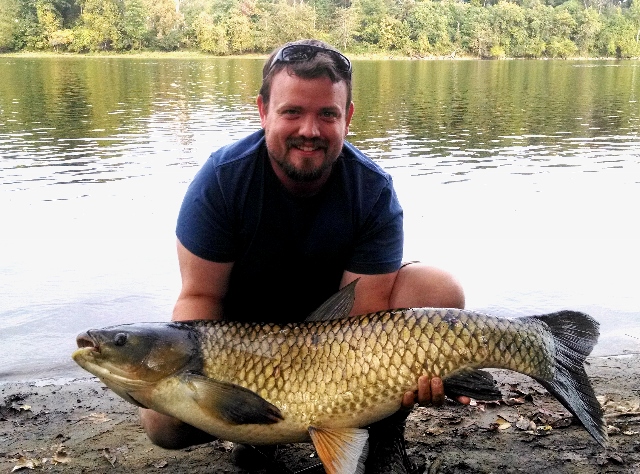Some love them and others…well, they love them a lot less. Whatever your thoughts of grass carp are, there is no denying that they achieve some very impressive proportions and can be found over much of the United States. They have been stocked in many waters for weed control and even small ponds can have 50+ lb fish, making them by far the largest fish available in many areas.

Grass carp (Ctenopharyngodon idella) is a native of the Amur River system in Asia, which also gives rise to one of it’s other common names, the white amur. It has been introduced nearly worldwide for control of aquatic vegetation, but this has not always worked as planned many different plant species are consumed and habitat for other fish species can be lost. Stocking of grass carp today is done with triploid fish that are not able to reproduce and are supposed to allow better control of vegetation. They are easy to distinguish from Common carp as they lack barbels and their mouth is terminal (at the end of the body).

In the spring grass carp often try and make a spawning run up tributaries…even if they are triploid and will not be able to spawn. This is a good time to look for them below dams or other obstructions to upstream movement. During the rest of the year they can be found anywhere there is food, which in lakes is often in the backs of coves and in rivers is around back waters. Also I have done well with them even in the winter so long as it is not too cold – the fish pictured above was captured in January.

Locating a place to catch grass carp is normally fairly simple. As they are stocked in many waters, management agencies can normally direct you to waters that have them. If in doubt grass carp tend to be easy to spot while fishing as they will suspend just below the surface as they look for food. Even waters that don’t have a regular stocking program tend to have a few if it is part of a larger drainage because grass carp stocked in private ponds tend to escape and look for new homes. If you need a starting place to look for them check out this USGS page that has a map of the waters that are known to contain grass carp. This is certainly not complete, however, and the small pond down the road might have some 40+lb fish in it.

Catching grass carp offers anglers a great deal of chance for personal expression as they can be caught in just about every way a common can. Grass carp are fond of feeding on the surface and will take floating baits under the right conditions. Bread is most often one of the best baits for this but chunks of bagel are tougher and will stay on the hook better. Another option is to feed them on pieces of bread and then use bagel or fake bread on the hook or hair. While this is the most exciting way to catch them I have found that it is more reliable to target them on the bottom using normal common carp rigs and often bait. Grass carp are known to enjoy eating fruity baits, and I have done well with pineapple, plum, and strawberry flavors. Often overlooked bait for grass carp are fishy ones. My PB grass carp was taken on a homemade boilie in strawberry and shrimp flavor and I have caught lots on cranberry squid and straight up squid boilies as well so it pays to keep your options open. If you are fishing in smaller ponds or at close range you can free line chunks of fresh fruit as well. My first grass carp fell to a chunk of canned pineapple!

Rigs for grass carp can be any that you like for common carp but you may want to use a larger size as these fish have larger mouths than their common cousins. I have found a size 4 or larger to be just fine for all but the smallest fish. Grass carp don’t seem to be all that adept at ridding themselves of a hook so rigs don’t have to be as super refined – that being said, a good rig will always catch you more fish, so just make sure your rig turns over and is of course safe! I have found a snowman bait arrangement to work well with a blowback rig for these fish.

A word of caution when using free-lined bait is in order as I have had grass carp swallow the hook…deep. Unlike their common cousins they don’t seem to necessarily get hooked when trying to rid themselves of the hook, so save yourself and the fish and pay close attention when using no weight. If the hook is really deep it is best to cut the line as close as you can to the fish and unless the hook is stainless or in a bad spot it will likely rust out and the fish will be fine.

And lastly here is a location tip from my own experience: if you are looking for a destination to catch big (and plentiful) grass carp (and some good commons too), check out the Congaree River and Santee-Cooper Lakes in South Carolina. This system is full of 40+lb fish and there are 60+lb fish to be had.

